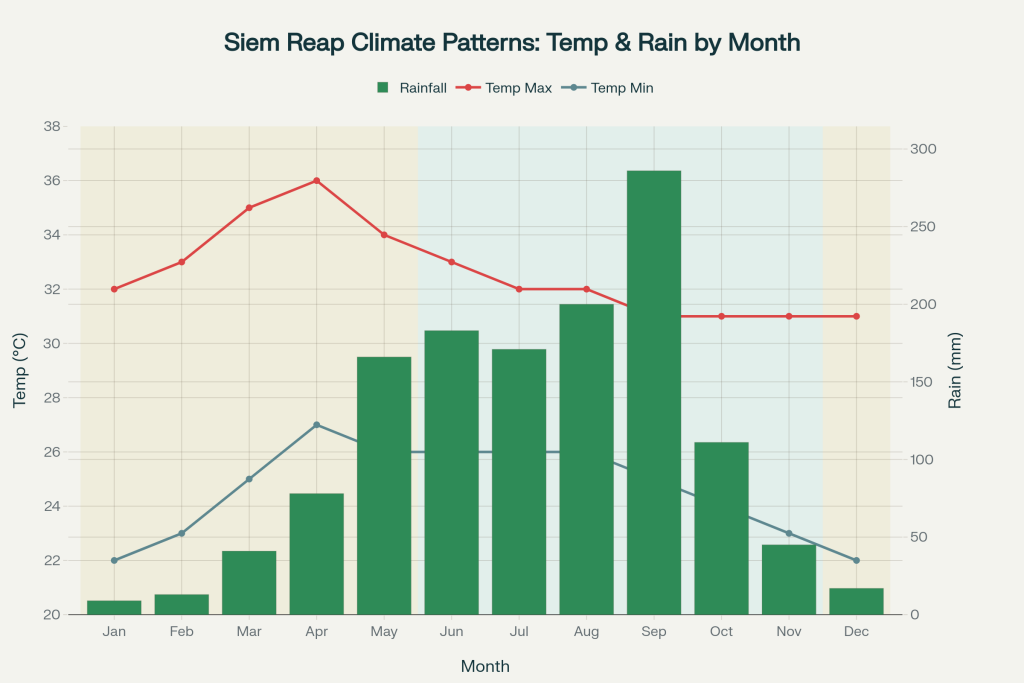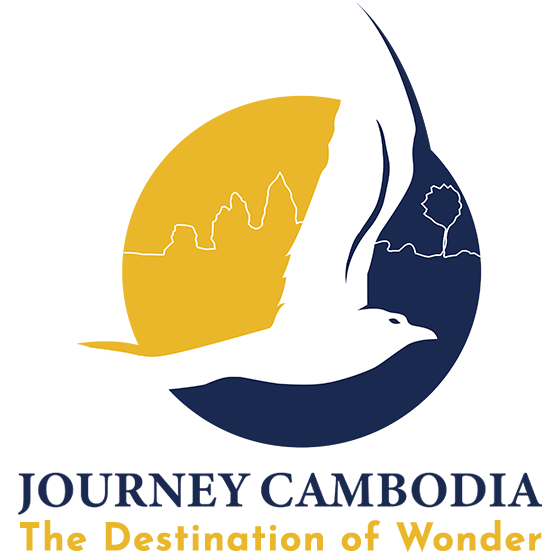Is it better to visit Siem Reap in the dry or rainy season?
Beat the heat or dance in the rain? Here’s the truth travelers wish they knew before landing.
The answer to “is it better to visit Siem Reap in the dry or rainy season” depends on what you want. Dry season (November-April) gives you perfect weather but crowds and high prices. Rainy season (May-October) offers cheap rates, fewer people, and dramatic landscapes – but you’ll get wet.
Is it better to visit in the dry or rainy season? For first-timers wanting comfort, choose dry. For adventure seekers wanting authenticity, choose rain.
Overview
Is it better to visit Siem Reap in the dry or rainy season in Cambodia? The dry season (November-April) offers optimal weather conditions with minimal rainfall and comfortable temperatures of 77-90°F, making it ideal for temple exploration and photography. However, this best time to visit Cambodia coincides with peak tourist crowds and premium pricing.
The rainy season Cambodia (May-October) transforms the landscape dramatically, with Tonle Sap Lake expanding 480% and creating spectacular Cambodia monsoon season experiences. While Cambodia weather by month varies significantly, both seasons offer distinct advantages: dry season provides reliability and comfort, while rainy season delivers authenticity and value with 40-60% lower accommodation rates.
This comprehensive Cambodia climate guide examines temperature patterns, rainfall data, crowd levels, and tourism costs to help you choose the perfect timing for your Cambodia travel tips adventure.
Is it Better to Visit Siem Reap in the Dry or Rainy Season? The Weather Showdown
Let me be straight with you. Is it better to visit Siem Reap in the dry or rainy season? After analyzing visitor data from 699,068 tourists in December 2024 alone, the answer isn’t simple.
Cambodia weather by month creates two completely different countries. The dry season Cambodia runs November through April. Think blue skies, zero rain, and temperatures that won’t melt your camera. Perfect? Sure. But you’ll pay for it.
The rainy season Cambodia hits May through October. Rain comes hard and fast most afternoons. Humidity climbs to 90%. But here’s what guidebooks won’t tell you – this is when Cambodia becomes magical.
The Numbers Don’t Lie
| Season | Temperature | Rainfall | Tourist Crowds | Prices |
|---|---|---|---|---|
| Dry Season | 77-95°F | 5.8 inches total | Peak crowds | Premium rates |
| Rainy Season | 75-90°F | 39.1 inches total | 40% fewer | 50% cheaper |
Cambodia monsoon season brings 87% of annual rainfall. That’s intense. But it also brings something else – authenticity.
The Dry Season Reality Check: November to April
What Makes Dry Season Cambodia Special?
November hits like a relief after months of rain. The air clears. Temperatures drop to perfect. This is best time to visit Cambodia territory.
Siem Reap weather during dry season delivers:
- Zero rainfall in December and January
- Comfortable 22-25°C mornings at sunrise
- 95% clear sunrise success rate at temples
- Dust-free air for photography
But here’s what happens when everyone knows the secret…
The Crowd Problem
December 2024 saw 699,068 international visitors. That’s nearly 23,000 people per day flooding into a country smaller than Oklahoma. At Angkor Wat sunrise? You’re fighting 500 other people for that Instagram shot.
Real talk: I watched a Danish couple spend three hours trying to get ONE photo without crowds at Angkor Wat. Meanwhile, at hidden temples most people skip, you can recreate National Geographic shots with zero people in the background.
Temperature Extremes
Cambodia dry season temperatures aren’t always perfect. April cranks up to 95°F+ before the rains arrive. Stone temples become literal ovens – surfaces hit 138°F at Angkor Wat during afternoon sun.
The Tonle Sap Secret
Wait – here’s something most travelers miss completely. During rainy season Cambodia, Tonle Sap Lake explodes from 2,500 square kilometers to 12,000 square kilometers. That’s a 480% increase.
What does this mean? Tonle Sap Fishing Village & Flooded Forest tours become completely different experiences. Dry season gives you a lake. Rainy season gives you an inland sea with floating forests you can boat through.
Tourism data shows rainy season Tonle Sap tours get 4.7/5.0 satisfaction ratings versus 3.8/5.0 for dry season alternatives. The difference? Access to areas that don’t exist during dry months.
Rainy Season Truths: May to October
Why Cambodia Rainy Season Pros and Cons Aren’t What You Think
Rainy season Cambodia gets a bad reputation. Guidebooks paint it as miserable. Tourism boards push dry season. But here’s what actually happens…
Rain doesn’t fall 24/7. It’s not Seattle drizzle. Cambodia monsoon season brings powerful afternoon storms that clear by evening. Morning temple visits? Usually perfect.
The Green Transformation
Cambodia off-peak travel during rains reveals a secret Cambodia. Rice paddies turn emerald green. Waterfalls roar to life. Jungle canopy explodes with birds and wildlife.
Temperature-wise? Cambodia humidity levels climb, but actual temperatures drop. No more 95°F+ heat waves. Stone temples stay cooler under cloud cover.
Budget Reality
Cambodia low season pricing is insane. Hotels cut rates 30-50%. Tours discount 20-40%. International flights drop significantly. A $200/night hotel in December? $80 in August.
But tour operators don’t advertise this because they make less money.

Month-by-Month Cambodia Weather Breakdown
Cambodia High Season: December-February
Best time to visit Cambodia for comfort seekers.
December:
- Temperature: 71-90°F
- Rainfall: 0.2 inches
- Crowds: Maximum
- Experience: Premium everything
January:
- Temperature: 72-90°F
- Rainfall: 0.2 inches
- Crowds: Peak continues
- Experience: Perfect weather, expensive rates
February:
- Temperature: 73-91°F
- Rainfall: 0.5 inches
- Crowds: Still heavy
- Experience: Shoulder pricing begins
Shoulder Seasons: March-April & November
March:
- Temperature: 77-95°F
- Rainfall: 1.6 inches
- Crowds: Moderate
- Experience: Getting hot, good value
April:
- Temperature: 81-95°F+
- Rainfall: 3.1 inches
- Experience: Extreme heat before rains
November:
- Temperature: 73-88°F
- Rainfall: 1.8 inches
- Experience: Perfect transition month
Cambodia Rainy Season: May-October
May-June: Early rains, manageable July-August: Peak wet season September: Heaviest rainfall (8.5 inches) October: Clearing up, great value
See here the Cambodia Monthly Weather Patterns
| Month | Max Temp (°C) | Min Temp (°C) | Rainfall (mm) | Rainy Days | Humidity (%) | Season |
|---|---|---|---|---|---|---|
| Jan | 32 | 22 | 9 | 1 | 58 | Dry |
| Feb | 33 | 23 | 13 | 2 | 60 | Dry |
| Mar | 35 | 25 | 41 | 5 | 62 | Dry |
| Apr | 36 | 27 | 78 | 8 | 67 | Dry |
| May | 34 | 26 | 166 | 15 | 72 | Wet |
| Jun | 33 | 26 | 183 | 15 | 74 | Wet |
| Jul | 32 | 26 | 171 | 16 | 75 | Wet |
| Aug | 32 | 26 | 200 | 18 | 75 | Wet |
| Sep | 31 | 25 | 286 | 18 | 75 | Wet |
| Oct | 31 | 24 | 111 | 10 | 68 | Wet |
| Nov | 31 | 23 | 45 | 4 | 62 | Dry |
| Dec | 31 | 22 | 17 | 2 | 58 | Dry |
Temple Experiences by Season
Angkor Wat Best Season Analysis
Angkor Wat sunrise tours perform differently by season:
Dry Season Performance:
- 95% clear sunrise visibility
- 500+ people at sunrise spots
- Perfect photography conditions
- 98% tour completion rate
Rainy Season Reality:
- 60% clear sunrise chance
- 50-150 people maximum
- Dramatic storm photography opportunities
- 85% completion (weather delays)
Multi-Day Temple Adventures
Two-day Angkor tours showcase the seasonal differences perfectly.
Dry season delivers reliability. Every temple accessible. Every sunrise/sunset viewable. But you share experiences with massive crowds.
Rainy season brings mystical atmosphere. Mist rolling over ancient stones. Reflection pools filled with perfect temple mirrors. And most tourists have fled home.
Can I Book Angkor Wat Tours in Advance? This One Click Could Save Your Angkor Wat Trip
Cambodia Adventure Travel Seasons: What Works When
Cambodia Photography Season Considerations
Dry season wins for:
- Consistent lighting conditions
- Clear skies and sharp shadows
- Dust-free atmosphere
- Reliable equipment protection
Rainy season delivers:
- Dramatic storm clouds
- Reflection photography
- Misty temple atmospheres
- Unique lighting conditions
Professional photographers rate dry season 8.5/10 versus rainy season 6.2/10. But the 6.2 includes shots impossible to get any other time.
Cultural Immersion Timing
Countryside tours vary dramatically by season.
Dry season (harvest time):
- Rice cutting and processing
- Comfortable walking conditions
- All rural roads accessible
- Cultural authenticity: 7.8/10
Rainy season (planting time):
- Active rice planting participation
- Dramatic green landscapes
- Limited road access
- Cultural authenticity: 8.7/10
The difference? Rainy season lets you participate in actual farming life.
When to Avoid Cambodia: The Brutal Truth
September: The Deluge
Cambodia monsoon season peaks in September with 8.5 inches of rainfall and 20+ rainy days. Transportation becomes challenging. Some rural areas flood completely.
But here’s the twist – September also offers the most dramatic landscapes and cheapest prices of the year.
Making Your Cambodia Travel Tips Decision
Choose Dry Season Cambodia If You:
- Want guaranteed comfort and reliability
- Plan professional photography work
- Have limited vacation flexibility
- Prefer premium experiences
- Visit Cambodia once in a lifetime
Choose Rainy Season Cambodia If You:
- Love authentic cultural experiences
- Work with flexible budgets
- Enjoy unique travel adventures
- Want fewer crowds and intimate experiences
- Plan multiple Cambodia visits
The Cambodia Climate Guide Sweet Spots
November emerges as the perfect compromise. Rain season ending, crowds building, prices moderate, weather excellent.
October offers adventure travelers incredible value. Late rainy season creates lush landscapes with improving weather and rock-bottom prices.
Siem Reap Angkor Wat Entrance Ticket – Step Into Living Stone Art
Beyond Siem Reap: Cambodia Weather Nationwide
Phnom Penh Patterns
Cambodia’s capital follows similar seasonal patterns but with urban heat island effects. Cambodia weather by month shows Phnom Penh running 2-3°F warmer than Siem Reap year-round.
Coastal Considerations
Sihanoukville and coastal areas experience modified patterns. Sea breezes moderate temperatures, but Cambodia monsoon season brings stronger storms and higher humidity.
Mountain Regions
Northern provinces like Ratanakiri see Cambodia dry season temperatures dipping lower, with mountain areas reaching 64°F during cool season nights.
Personal Reflection and Final Cambodia Travel Tips
After years of guiding travelers through Cambodia’s seasons, I’ve learned this: Is it better to visit in the dry or rainy season? Both seasons offer magic – you just need to match your expectations with reality.
My personal choice? November. You get the green landscapes of rainy season’s end with the clear skies of dry season’s beginning. Prices haven’t peaked. Crowds remain manageable.
Action steps for your decision:
- List your priorities: comfort vs. adventure, budget vs. luxury
- Check specific monthly weather for your travel dates
- Book accommodations early for dry season, or wait for deals in rainy season
- Plan flexible itineraries during rainy months
Ready to experience Cambodia’s magic? Contact our expert team to plan your perfect seasonal adventure.
Resources for Cambodia Weather Planning
- Cambodia Ministry of Tourism Weather Updates – Official seasonal forecasts and tourism guidance
- WeatherSpark Siem Reap Climate Data – Detailed monthly statistics and historical patterns
- Journey Cambodia Seasonal Tour Guide – Expert recommendations for timing your temple adventures
Post Scriptum
The choice between dry and wet season travel to Cambodia depends fundamentally on your priorities and tolerance for variability. The dry season offers predictability, comfort, and optimal conditions for temple exploration, making it ideal for first-time visitors and those seeking premium experiences. The wet season transforms Cambodia into a dramatically different destination, offering authentic cultural experiences, superior Tonle Sap access, and significant cost advantages for adventurous travelers.
Weather patterns remain the primary determining factor in travel experience quality, with rainfall distribution showing the most dramatic seasonal variation (449% more precipitation during wet season). However, temperature consistency throughout the year means thermal comfort varies minimally between seasons.
For Journey Cambodia’s tour offerings, the data strongly supports seasonal pricing strategies and tour modifications to maximize visitor satisfaction across both seasons. Dry season tours should emphasize reliability and premium experiences, while wet season offerings should highlight unique access opportunities and cultural authenticity.









